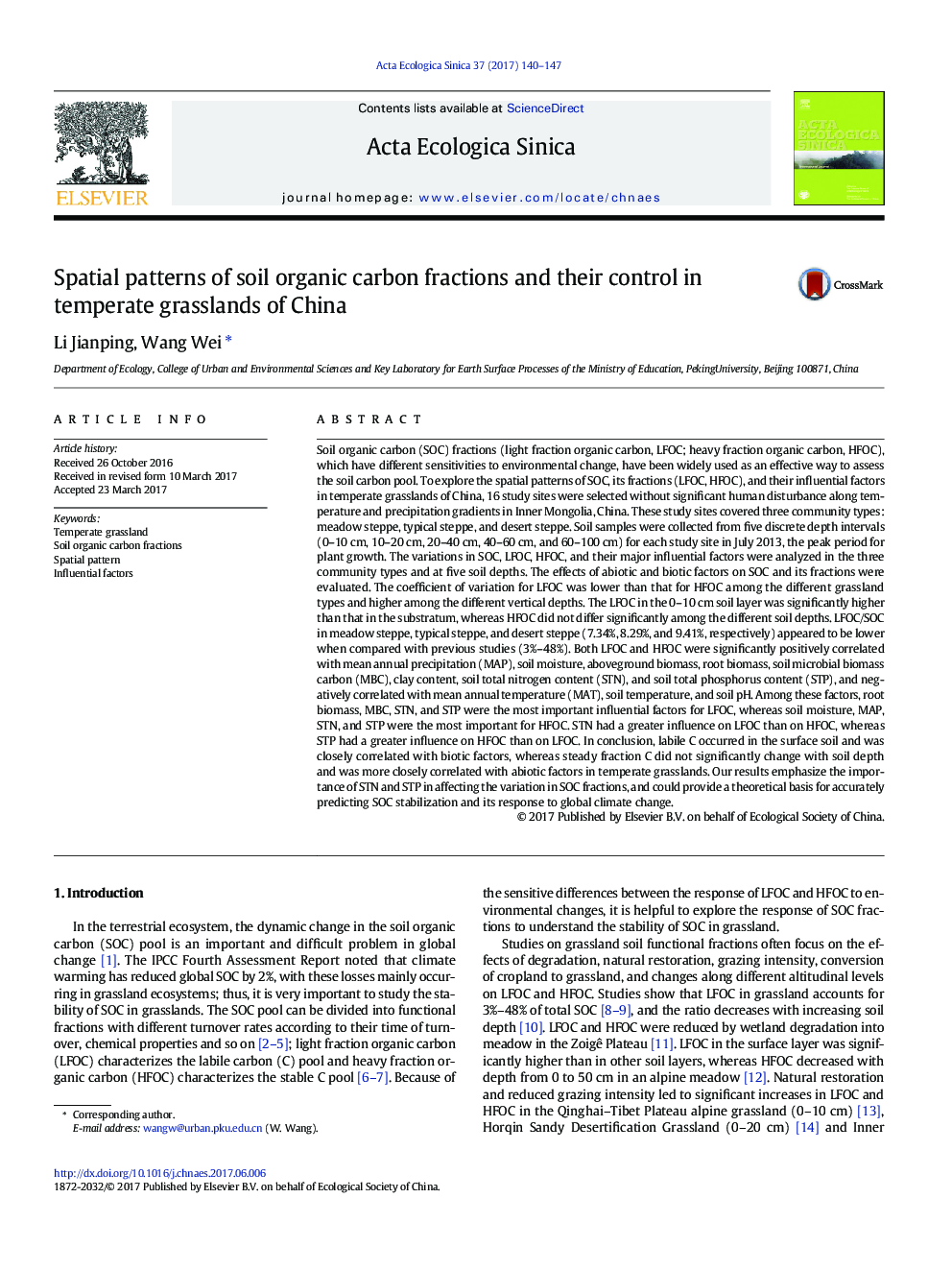| کد مقاله | کد نشریه | سال انتشار | مقاله انگلیسی | نسخه تمام متن |
|---|---|---|---|---|
| 8846372 | 1617674 | 2017 | 8 صفحه PDF | دانلود رایگان |
عنوان انگلیسی مقاله ISI
Spatial patterns of soil organic carbon fractions and their control in temperate grasslands of China
ترجمه فارسی عنوان
الگوهای فضایی کسرهای خاکی آلی خاک و کنترل آنها در چمنزارهای معتدل چین
دانلود مقاله + سفارش ترجمه
دانلود مقاله ISI انگلیسی
رایگان برای ایرانیان
کلمات کلیدی
علفزار معطر، کسر کربن خاکی، الگوی فضایی، عوامل موثر،
موضوعات مرتبط
علوم زیستی و بیوفناوری
علوم کشاورزی و بیولوژیک
بوم شناسی، تکامل، رفتار و سامانه شناسی
چکیده انگلیسی
Soil organic carbon (SOC) fractions (light fraction organic carbon, LFOC; heavy fraction organic carbon, HFOC), which have different sensitivities to environmental change, have been widely used as an effective way to assess the soil carbon pool. To explore the spatial patterns of SOC, its fractions (LFOC, HFOC), and their influential factors in temperate grasslands of China, 16 study sites were selected without significant human disturbance along temperature and precipitation gradients in Inner Mongolia, China. These study sites covered three community types: meadow steppe, typical steppe, and desert steppe. Soil samples were collected from five discrete depth intervals (0-10Â cm, 10-20Â cm, 20-40Â cm, 40-60Â cm, and 60-100Â cm) for each study site in July 2013, the peak period for plant growth. The variations in SOC, LFOC, HFOC, and their major influential factors were analyzed in the three community types and at five soil depths. The effects of abiotic and biotic factors on SOC and its fractions were evaluated. The coefficient of variation for LFOC was lower than that for HFOC among the different grassland types and higher among the different vertical depths. The LFOC in the 0-10Â cm soil layer was significantly higher than that in the substratum, whereas HFOC did not differ significantly among the different soil depths. LFOC/SOC in meadow steppe, typical steppe, and desert steppe (7.34%, 8.29%, and 9.41%, respectively) appeared to be lower when compared with previous studies (3%-48%). Both LFOC and HFOC were significantly positively correlated with mean annual precipitation (MAP), soil moisture, aboveground biomass, root biomass, soil microbial biomass carbon (MBC), clay content, soil total nitrogen content (STN), and soil total phosphorus content (STP), and negatively correlated with mean annual temperature (MAT), soil temperature, and soil pH. Among these factors, root biomass, MBC, STN, and STP were the most important influential factors for LFOC, whereas soil moisture, MAP, STN, and STP were the most important for HFOC. STN had a greater influence on LFOC than on HFOC, whereas STP had a greater influence on HFOC than on LFOC. In conclusion, labile C occurred in the surface soil and was closely correlated with biotic factors, whereas steady fraction C did not significantly change with soil depth and was more closely correlated with abiotic factors in temperate grasslands. Our results emphasize the importance of STN and STP in affecting the variation in SOC fractions, and could provide a theoretical basis for accurately predicting SOC stabilization and its response to global climate change.
ناشر
Database: Elsevier - ScienceDirect (ساینس دایرکت)
Journal: Acta Ecologica Sinica - Volume 37, Issue 3, June 2017, Pages 140-147
Journal: Acta Ecologica Sinica - Volume 37, Issue 3, June 2017, Pages 140-147
نویسندگان
Li Jianping, Wang Wei,
